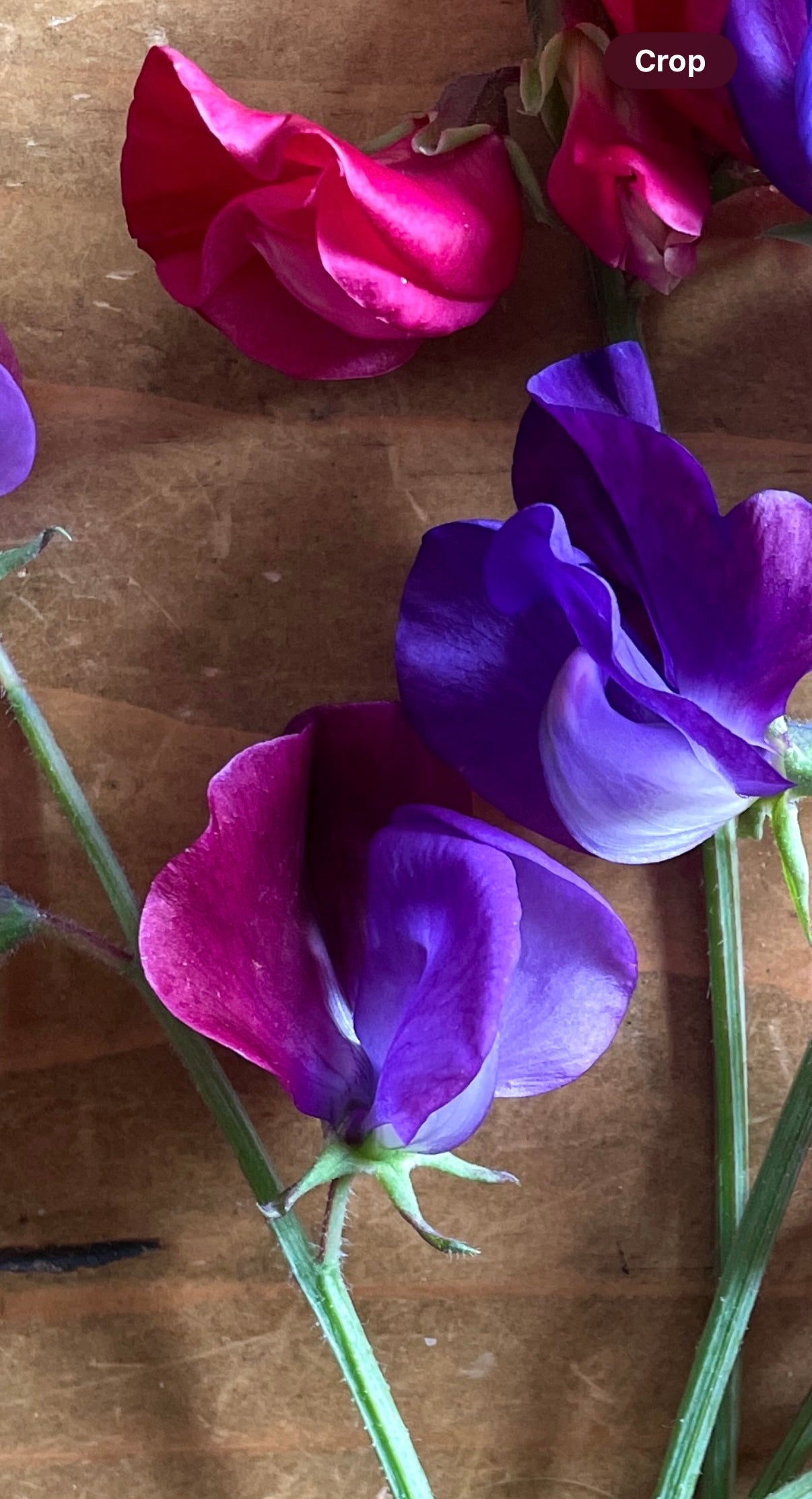Sweet Pea 'Purple Pimpernel' Seeds
'Purple Pimpernel' is a stunning bi-colour Sweet Pea that demands attention. It features rich, velvety maroon-purple upper petals (standards) contrasted against vibrant violet-blue lower petals (wings). This two-tone effect gives the flowers a depth and complexity that solid colours just can't match.
This is a variety that looks incredible in a vase. The dark, moody colours add a touch of luxury and sophistication to bouquets. Like its famous cousin the 'Scarlet Pimpernel', this variety is vigorous, producing long, strong stems that are perfect for cutting, all while carrying a lovely, sweet fragrance.
Why Your Garden Needs 'Purple Pimpernel'
We love this variety for its visual impact. From a distance, the flowers seem to shimmer as the two shades of purple catch the light. It is perfect for adding a "moody" or "regal" note to your garden colour scheme.
It is also a workhorse. As a vigorous climber, it will quickly cover a trellis or wigwam, creating a lush screen of green foliage studded with jewel-like flowers. It is reliable, robust, and keeps blooming as long as you keep picking.
Understanding the Plant: What is a Hardy Annual?
Sweet Peas are **Hardy Annuals**.
They live for one season but are tough enough to survive a cold winter.
The Strategy: For exhibition-quality blooms on the longest stems, sow in Autumn (Oct/Nov) and overwinter the young plants in a cold frame. For an easier, relaxed garden display, sow in Spring (Jan-March).
Top Tip: Sweet Peas are deep rooters. Sow them in "root trainers," deep pots, or even empty toilet roll tubes to give the roots plenty of vertical space to grow.
Growing Guide: How to Sow and Grow
Sweet Peas are hungry plants that thrive on rich soil and regular picking.
🌱 Germination:
Sow indoors in Oct/Nov or Jan-March. You can soak the seeds in tepid water for a few hours before sowing to soften the hard coat. Sow 1cm deep in moist compost. Keep cool (approx 15°C)—heat inhibits germination! They usually sprout in 10-21 days.
Where to Sow:
They need **full sun** and rich, fertile soil. Dig a trench and fill it with well-rotted manure or compost before planting out. Ensure you have a strong support structure (wigwam, trellis, or netting) ready for them to climb.
Care While Growing:
Tie them in: Use soft twine or sweet pea rings to guide the stems up the support.
Feed: Once flower buds appear, feed weekly with a high-potash fertiliser (tomato feed).
Pick, Pick, Pick! You must remove seed pods immediately. If the plant sets seed, it assumes its job is done and stops flowering. Harvest flowers every 2 days.
Plant Specifications
Here is a quick reference guide to the key features.
| Latin Name | Lathyrus odoratus |
| Common Name | Sweet Pea 'Purple Pimpernel' |
| Hardiness | H3 (Hardy Annual) |
| Light Required | Full Sun ☀️ |
| Height | ↕️ 1.8m - 2.4m (Climber) |
| Spread | ↔️ 30cm |
| Spacing | 🌱 20cm - 30cm apart |
| Great for | 💜 Bi-colour Blooms ✂️ Cut Flowers 👃 Scented Gardens 🪜 Covering Fences |
| Seed Count | Approx. 20 seeds per packet |
My Recommended Garden Companions
The rich purple tones of 'Pimpernel' need light, fresh companions to stop them disappearing against a dark fence:
- 🍋 Larkspur 'Limelight Mix': A zesty contrast. The greenish-white spikes of the Larkspur lift the dark purple of the Sweet Pea, creating a vibrant, modern look in both the garden and the vase.
- ❄️ Ammi Majus (Queen Anne's Lace): The essential brightener. The flat, white lacy heads of Ammi Majus act as a spotlight, illuminating the deep velvet tones of the Sweet Pea flowers.
📅 Sowing & Flowering Calendar
Sow in Autumn for early flowers, or Spring for summer blooms.
(↔️ Swipe chart to see all months)
| Month | J | F | M | A | M | J | J | A | S | O | N | D |
|---|---|---|---|---|---|---|---|---|---|---|---|---|
| Sow Seeds | 🟢 | 🟢 | 🟢 | 🟢 | 🟢 | |||||||
| Flowers | 🌸 | 🌸 | 🌸 | 🌸 |
⚠️ Toxicity Warning
Sweet Pea seeds are mildly toxic if eaten in large quantities. Unlike vegetable garden peas, these pods are not for eating. Please keep seeds away from small children.
🏆 Officially Recognised Excellence
Sweet Peas are fantastic for bees. Lathyrus odoratus is listed on the RHS Plants for Pollinators list, acting as an important nectar source in the kitchen garden.
- Regular price
-
£2.20 - Regular price
-
- Sale price
-
£2.20
Couldn't load pickup availability




Sweet Pea Purple Pimpernell
- Regular price
-
£2.20 - Regular price
-
- Sale price
-
£2.20




